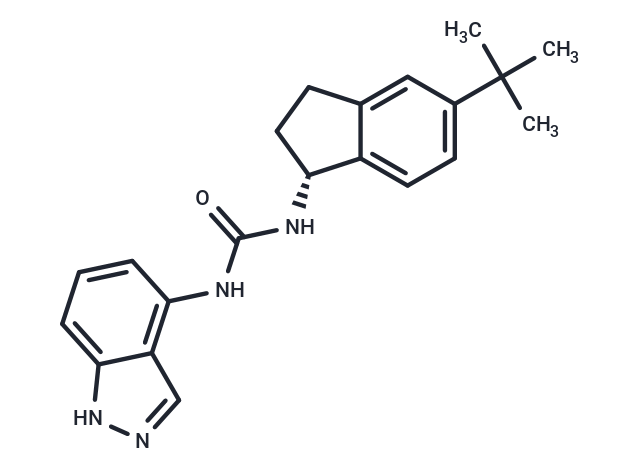Shopping Cart
Remove All Your shopping cart is currently empty
Your shopping cart is currently empty
ABT 102 (CHEMBL398338) is a selective antagonist of transient receptor potential vanilloid 1 (TRPV1) receptor.

| Pack Size | Price | USA Warehouse | Global Warehouse | Quantity |
|---|---|---|---|---|
| 1 mg | $117 | In Stock | In Stock | |
| 5 mg | $262 | In Stock | In Stock | |
| 10 mg | $388 | In Stock | In Stock | |
| 25 mg | $592 | In Stock | In Stock | |
| 50 mg | $828 | In Stock | In Stock | |
| 100 mg | $1,110 | In Stock | In Stock | |
| 200 mg | $1,480 | - | In Stock | |
| 1 mL x 10 mM (in DMSO) | $272 | In Stock | In Stock |
| Description | ABT 102 (CHEMBL398338) is a selective antagonist of transient receptor potential vanilloid 1 (TRPV1) receptor. |
| Synonyms | CHEMBL398338, ABT-102, ABT102 |
| Molecular Weight | 348.44 |
| Formula | C21H24N4O |
| Cas No. | 808756-71-0 |
| Smiles | N(C(NC1=C2C(NN=C2)=CC=C1)=O)[C@H]3C=4C(=CC(C(C)(C)C)=CC4)CC3 |
| Relative Density. | 1.31g/cm3 |
| Storage | Powder: -20°C for 3 years | In solvent: -80°C for 1 year | Shipping with blue ice/Shipping at ambient temperature. | |||||||||||||||||||||||||||||||||||
| Solubility Information | DMSO: 45 mg/mL (129.15 mM), Sonication is recommended. | |||||||||||||||||||||||||||||||||||
| In Vivo Formulation | 10% DMSO+40% PEG300+5% Tween-80+45% Saline: 2 mg/mL (5.74 mM), Sonication is recommeded. Please add the solvents sequentially, clarifying the solution as much as possible before adding the next one. Dissolve by heating and/or sonication if necessary. Working solution is recommended to be prepared and used immediately. The formulation provided above is for reference purposes only. In vivo formulations may vary and should be modified based on specific experimental conditions. | |||||||||||||||||||||||||||||||||||
Solution Preparation Table | ||||||||||||||||||||||||||||||||||||
DMSO
| ||||||||||||||||||||||||||||||||||||
| Size | Quantity | Unit Price | Amount | Operation |
|---|

Copyright © 2015-2025 TargetMol Chemicals Inc. All Rights Reserved.